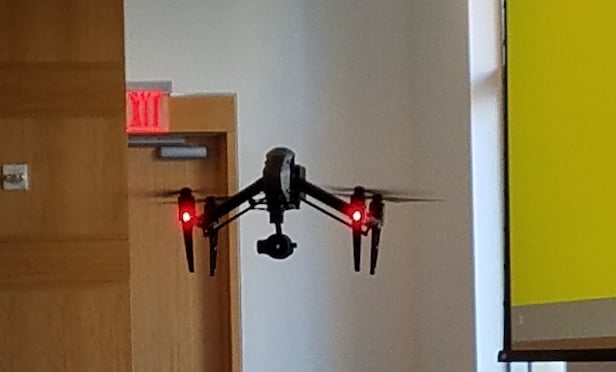 File photo: UAS drone piloted by MC Consultants, Inc. at Mortgage Bankers Association of New York and Fordham Real Estate Institute Real Estate and Lending Summit, June 19, 2018/ Photo by Betsy Kim
File photo: UAS drone piloted by MC Consultants, Inc. at Mortgage Bankers Association of New York and Fordham Real Estate Institute Real Estate and Lending Summit, June 19, 2018/ Photo by Betsy Kim
NEW YORK CITY—Camber Creek's general partner Jake Fingert sees drones as a CRE disrupter.
The venture capital firm solely focuses on investing in real estate technologies. Fingert formerly served as a senior policy advisor in President Barack Obama's White House and was a senior advisor at the General Services Administration (GSA). In both roles he identified new investments and managed operations for the federal government's infrastructure and real estate portfolio of more than 350 million square feet.
The robotic spiders hunting fugitives depicted in the 2002 film “Minority Report” or the flying insect recording terrorists in the 2015 movie “Eye in the Sky” are a bit more thrilling and dramatic than today's CRE drones. But drones are actively used in commercial real estate and Fingert predicts this will continue to grow.
Since 2011, Camber Creek has been in the proptech space. All their investors are owners and operators of real estate and real estate-related companies. Fingert states in the last three years the number of drone companies that his firm has considered to invest in has increased tenfold. He notes that many of the top 100 real estate companies in the country use drones.
They are frequently used for marketing purposes to give video tours. “Drones with cameras can help property owners tell a more compelling story about their property,” says Fingert. “They are being used to do flyovers over buildings.”
He also points out drones are helping to manage construction sites. “With the right software packages, drones can help contractors and developers manage site inventory or constructions they are planning, making sure the equipment and materials are onsite at the right time.”
 Jake Fingert, general partner, Camber Creek
Jake Fingert, general partner, Camber CreekDrones are also being used to assist with security, for example, at data centers or industrial sites with large gated perimeters. In the time it takes a security guard to walk over and check out specific areas, a drone can get to the space in a matter of seconds. “If you have a camera you can see what's going on and that increases the safety and efficiency of the security workers onsite,” explains Fingert.
He foresees future uses in five or so years of drones combined with robotics to handle more dangerous, expensive work. This includes fixing utility towers, repairing roofs or doing work to reduce the human death toll with certain occupations to zero. However, he notes the technology and regulations are not yet there.
Amazon and other companies are looking to use drones to more efficiently deliver purchases from fulfillment centers to buyers' homes. In Cambridge, England, Amazon is already developing Amazon Air, a service where drones deliver packages weighing five pounds or less, in 30 minutes or faster.
Drones face heavy regulations particularly around major cities. Regulations would apply to drones of different sizes and those used for different purposes. Fingert states federal, state and local governments are recognizing they will need to work hand-in-hand with businesses to create the regulations.
“You can envision a future where we will see dedicated drone routes like highways where you are only allowed to fly drones in the certain lanes, for deliveries, for example,” he says. “It's worth noting in other countries regulations are a lot lighter than in the US which is opening up the impact on real estate.”
Fingert points out regulations would need to very clear—commenting it is not coincidental that Amazon selected its other HQ2 near Washington, DC. Recognizing privacy concerns, he acknowledges the “Big Brother” surveillance capabilities of drones still leave many people feeling uneasy. A 2015 Reuters/IPSOS poll found 42% of respondents disapproved ownership of drones by private citizens with 73% wanting drones to be regulated. With community concerns weighed against the benefits of the technology, “There needs to be a balance struck,” he says.
© Touchpoint Markets, All Rights Reserved. Request academic re-use from www.copyright.com. All other uses, submit a request to [email protected]. For more inforrmation visit Asset & Logo Licensing.







